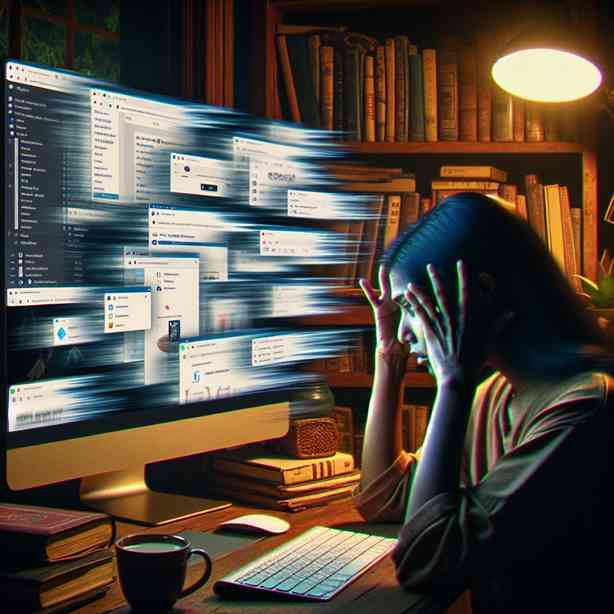
Screen flickering can be a frustrating experience, and it often seems to occur without any apparent reason. This problem may stem from various factors, and understanding these can help you diagnose and address the issue effectively. In this detailed exploration, we will examine the potential causes of screen flickering, how to troubleshoot it, and the steps you can take to prevent it from happening in the future.
Firstly, let’s consider the hardware components involved in your display system. A flickering screen can be a symptom of a failing hardware part. Monitor cables play a critical role in transmitting the video signal from your computer’s graphics card to your monitor. If these cables are loose, damaged, or frayed, it could lead to a flickering display. Ensure that the cables are securely connected and consider replacing any that show visible signs of wear or damage.
Next, we should examine the graphics card. This component is responsible for rendering images and video on your screen. If your graphics card is malfunctioning due to overheating or age, it may cause the screen to flicker. Checking for dust accumulation and ensuring that the graphics card is adequately cooled can sometimes resolve this issue. If the problem persists, testing the graphics card in another system or using a different one in your current setup can help you determine whether the card itself is the issue.
Another important factor to consider is your monitor settings. Refresh rates play a significant role in how smoothly images are displayed on the screen. A refresh rate that is not properly set can lead to flickering. To adjust this setting, navigate to your display settings on your operating system and select a refresh rate that is recommended for your monitor. Common refresh rates are 60Hz, 75Hz, and 144Hz, depending on the type of monitor you have. Selecting an incompatible refresh rate can lead to display issues, so it’s crucial to choose the correct one.
Software conflicts can also lead to screen flickering. Outdated or incompatible drivers for your graphics card can cause instability in how visual data is processed. It is advisable to update your graphics drivers regularly. You can usually find the latest drivers on the manufacturer’s website. Additionally, ensure that your operating system is up to date. Sometimes, software updates include patches that fix known issues, including graphics-related problems.
If you are running multiple applications simultaneously or using resource-intensive programs, this can put a strain on your system and cause performance issues, including flickering. Closing unnecessary applications or freeing up resources through task management can help alleviate some of the strain. In more severe cases, upgrading your hardware—such as increasing RAM or replacing your graphics card—may be necessary to improve overall performance.
Additionally, external electromagnetic interference can cause flickering. Devices such as routers, speakers, and even fluorescent lights can produce interference that distorts the signals sent to the monitor. If possible, relocate your monitor or these devices to see if the flickering persists. Keeping these devices at a distance may significantly reduce interference and lead to a stable display.
If you are using a laptop, the problem might lie in the laptop’s power settings or the display technology used. Check your power management settings to ensure that your laptop is not throttling performance to save battery. Also, some laptops come equipped with adaptive refresh technology that can cause flicker if not functioning correctly. Disabling this feature in your graphics settings may resolve the issue.
Screen flickering can also be caused by faulty display panels, particularly in cheaper monitors or older devices. If you have tried all other troubleshooting steps and still experience flickering, consider that your monitor might be at fault. Testing your monitor with a different computer or connecting a different monitor to your current setup can help determine if the display itself is the cause. If the monitor is indeed the problem, you may need to consult the manufacturer for a repair or replacement.
Lastly, certain applications may be incompatible with your display configuration or not fully optimized for the hardware you are using. For example, applications that utilize hardware acceleration may behave erratically on specific configurations. Trying to disable hardware acceleration in these applications can sometimes fix flickering.
To summarize, while screen flickering can seem inexplicable at first, there are several common causes and solutions to consider. Checking your hardware connections, updating your graphics drivers, and adjusting your monitor settings are crucial first steps. Additionally, considering software conflicts, external interference, and the performance of your applications can lead you to a solution. If the problem persists, it may be worth evaluating your monitor for faults or consulting a professional technician to assist in diagnosing the issue.
Understanding the root of screen flickering is essential to ensuring a reliable and pleasant experience with your display. By tracking down potential problems and responding with the appropriate fixes, you can keep disruptions at bay and enjoy a smooth visual experience. If any concerns remain or troubleshooting does not yield results, reaching out to expert support or your device’s manufacturer may lead to the help needed to resolve these frustrating display issues.


